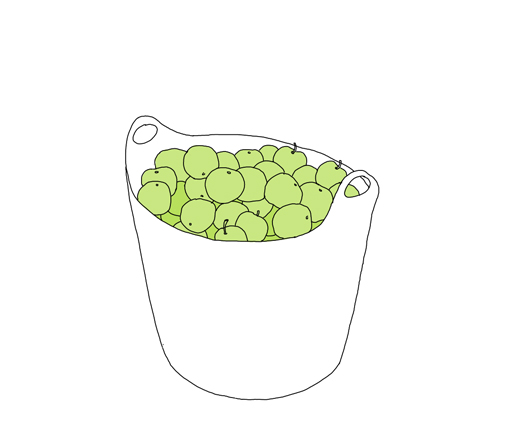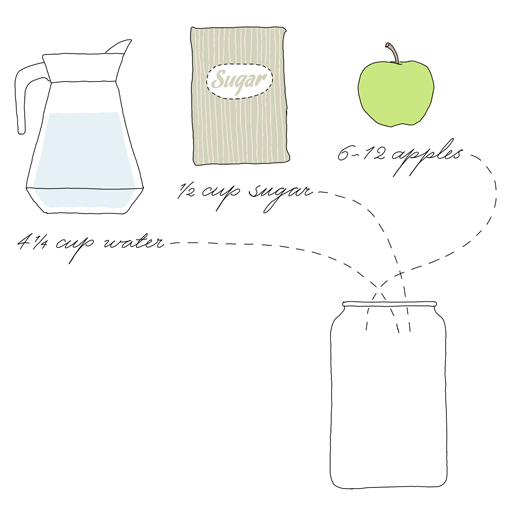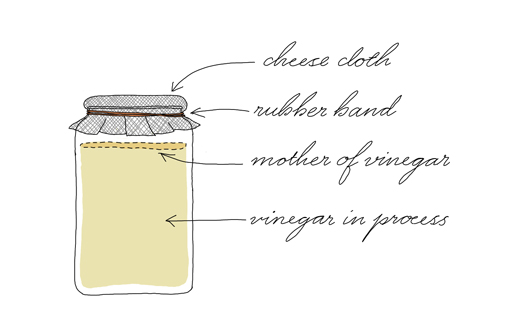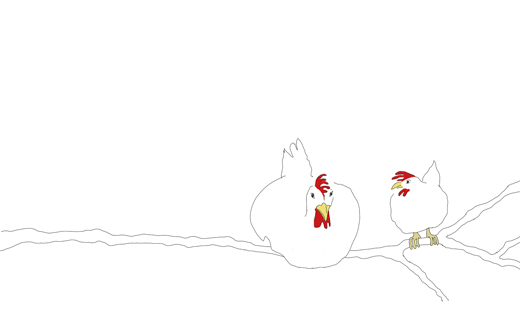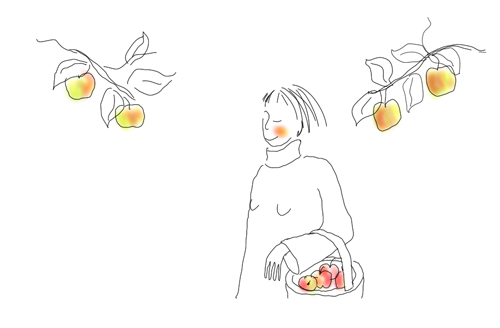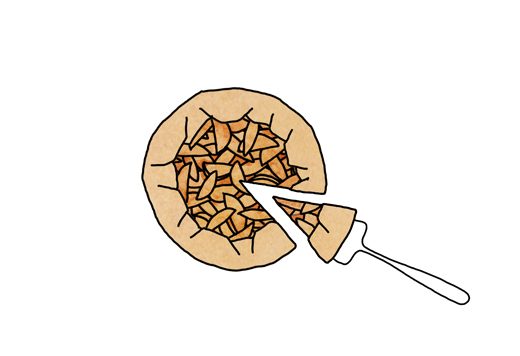
A flaky pie crust is delicious and perfect for sweet as well as savory pies and tarts. I use it mostly when making a free form galette like here below, but you can also bake it in a pie pan as a tart decorated with lattice, or like a classic covered pie.
And it’s a piece of cake to make it yourself. You just need to follow a few simple rules. To achieve a flaky rising crust use cold ingredients and at the same time develop just enough gluten for the dough to hold together. As the gluten is formed (from the protein in flour) when you are working the dough it’s important not to overwork it, as it will just result in a tough crust (which is better suited for something else). Keeping the fat (butter or lard) as visible solid pieces will magically create rising flaky layers when baked.
If you are only making a small tart like my recipe here, you can easily do it by hand or with a simple dough scraper as shown in my illustration below. If doing it with your bare hands, just make sure to rub the butter and flour lightly and quickly to avoid melting the butter with your warm fingertips. I recommend using a food processor if you are planning to make several batches at the same time, just make sure to pulse gently so you don’t overheat or cut the butter too much.
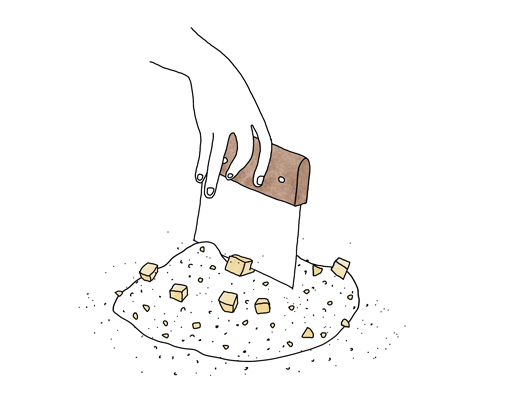
As it’s apple season I suggest to make a galette and fill it with apple slices that are cooked in butter, brown sugar, and lemon juice. But you can fill with many other seasonal things all year around; pears, peaches, strawberries, or rhubarb. And by leaving out the sugar in the dough, it can be used for savory tarts too. My favorite is a combination of sauteed mushrooms, roasted butternut squash, fresh tomatoes, and goat cheese.
I think this apple & lemon galette is a fantastic dessert for any Thanksgiving table. Serve it slightly warm with vanilla ice cream or heavy whipped cream. Happy Thanksgiving!
Please note that you will need to double the pie crust recipe if making a covered classic pie or a lattice decorated pie. Adjust measures and baking time accordingly.
Flaky Pie Crust for Apple & Lemon Galette
serves 6 to 8
flaky pie crust
1 ¼ cups (6.25 ounces, 180 grams) all-purpose flour
½ cup (4 oz, 113 g) cold unsalted butter, cut in chunks
1 tablespoon sugar (leave out if making a savory pie)
¼ teaspoon sea salt
1/3 cup ice cold water
filling
4 to 5 (about 1.5 oz, 700 g) crisp apples
4 tablespoons brown sugar
4 tablespoons (2 oz, 57 g) unsalted butter
juice of ½ lemon, about 3 tablespoons
a few handfuls of unsweetened coconut shreds
To prepare the pastry, place the flour, sugar, and salt directly on a flat surface. Add the butter on top. With a dough scraper (see diagram) chop the butter into roughly bean-size pieces. At the same time, toss the butter around to make sure it gets well coated with the dry ingredients. Add the ice water a little at a time and work the dough quickly until you can form a rough ball without any dry flour, beautifully marbled with visible “lumps” of butter. If needed add more ice water, one tablespoon at the time. Flatten the ball into a disc, wrap it with parchment paper and let rest in the refrigerator for at least 1 hour and up to a few days.
To prepare the filling: Peel and core the apples. Slice them thinly, approximately ¼ inch (about 6 mm) thick. In a saucepan melt the butter together with the sugar, stir occasionally. When the butter is melted add the apples followed by the lemon juice. Stir the apples to make sure they get evenly coated with the butter sauce. Cook on medium heat, until apples are slightly soft, stir occasionally. Strain the apples, but reserve the buttery liquid as it will be used as a glaze for the apples. Set aside to cool completely.
Preheat the oven to 400 F (200 C). Grease a baking sheet or line it with parchment paper or silicone mat.
 To roll out the dough, place the dough on a flat surface and dust lightly will all-purpose flour. If the dough is very stiff, you can soften it first by patting the dough with the rolling pin. This will make the dough softer and easier to roll. Roll the dough from the center and out, while continually turning the dough quarterly, to roughly 12 to 13 inch (30 to 36 cm) diameter. If the dough sticks to the surface, dust the surface lightly with more flour. If your kitchen is very warm you will need to pop the dough into your freezer for about five minute. This will prevent the butter from melting.
To roll out the dough, place the dough on a flat surface and dust lightly will all-purpose flour. If the dough is very stiff, you can soften it first by patting the dough with the rolling pin. This will make the dough softer and easier to roll. Roll the dough from the center and out, while continually turning the dough quarterly, to roughly 12 to 13 inch (30 to 36 cm) diameter. If the dough sticks to the surface, dust the surface lightly with more flour. If your kitchen is very warm you will need to pop the dough into your freezer for about five minute. This will prevent the butter from melting.
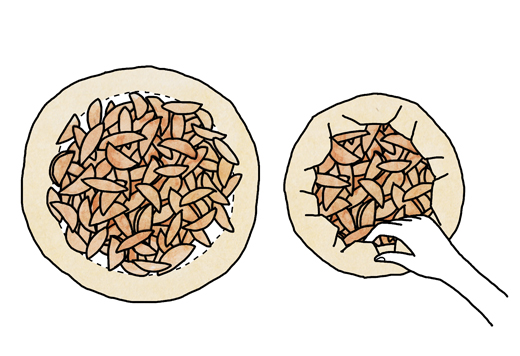
Dust off any loose flour on the rolled-out dough and place it on the prepared baking sheet. Sprinkle over the coconut shreds, leaving about 2 inch (almost 6 cm) border all around the edge. Arrange the apples on top. Fold the edges over and pinch overlapping dough together (see diagram).
Bake on the middle rack until crust is golden brown and fruit is baked through, about 25 to 30 minutes. Last 10 minutes, brush fruit with the apple butter sauce.
Serve warm with heavy whipped cream or vanilla ice cream.
*
related links
Puff pastry
illustrated kokblog recipe
Summer Fruit Galette
by David Lebovitz
10 Galettes That Are Easier Than, Well, Pie
Bon Appétit
Ginger & Lime Tart
illustrated kokblog recipe
Caramelized Apple Tart
illustrated kokblog recipe
more Thanksgiving ideas…
Duck Liver Starter
a good use of the liver when cooking a whole bird
(kokblog recipe)
Tired of dry Turkey? Try my
Duck in Port (kokblog recipe)
An Alternative Menu for Thanksgiving
with Anna Brones

